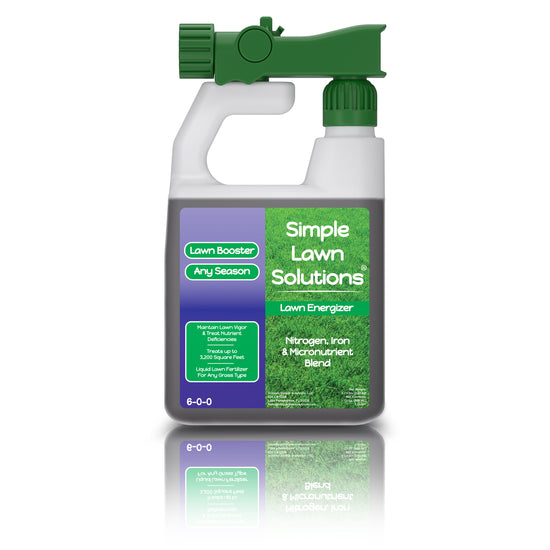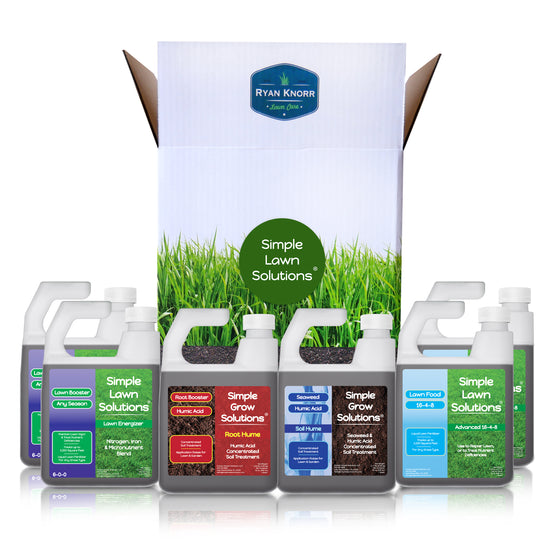NEW ARRIVAL
Simple Lawn Solutions
Ryan Knorr
Lawn Essentials Bundle Box
Introducing The Lawn Essentials Bundle Box. Six Piece Lawn Box includes Two Lawn Food Fertilizers (16-4-8), Two Lawn Boosters (Lawn Energizer), One Root Hume and One Soil Hume.
Application Guide For Grass Type
Warm Season Application Guide
-
Bermuda
-
St. Augustine
-
Centipede
-
Zoysia
Cool Season Application Guide
-
Kentucky Bluegrass
-
Tall Fescue
-
Fine Fescue
-
Ryegrass
Application Instructions
When it comes to applying products to your lawn you must know the square footage. This can be easily calculated by measuring each section of your lawn and multiplying the length x the width. For example, a small section of my lawn at my house is 17 ft wide by 35 ft long. Multiply those together and we arrive at 595 sq ft. I round this up to 600 just to make it an even number in my head.
- One of the 32 ounce bottles from Simple Lawn Solutions will cover 3200 sq ft when using the hose end method.
- When spraying multiple Simple Lawn Products on the same day it would generally work best to spray the lawn food first, then the lawn energizer product, and then finally the root hume last before watering these products in.
The soil loosener can be applied with these as well but also must be watered in .5 inches to help the product reach the soil layer.
Here is a video showing how I applied the liquids to my lawn - https://youtu.be/KgLVENZ4hVo
Soil Test
Testing your soil will give you the full picture of what nutrients your soil needs and will also provide you with the pH of your soil. Knowing your pH will be key in a plan going forward as there is an optimal range for growing turfgrass.
Video on how to conduct a soil test - https://youtu.be/hURWeYYBrIc
Liquid Fertilizer
When applying liquid fertilizer with Simple Lawn Solutions you have the benefit of feeding the grass plant directly through the leaves. With this in mind it is important that irrigation is completed after application and regularly to your lawn. Many granular fertilizers are coated and therefore break down more slowly over time. With liquids we are applying the fertilizer directly to the plant and the nutrients are taken in quickly but must be watered in.
- One bottle of fertilizer with the ready to use hose end sprayer covers 3200 sq ft
- Apply liquids in the early morning before 10am or preferably after 4pm and into the evening. Do not apply liquids during the heat of the day as damage can occur to the grass.
- Allow liquids to sit on the grass blades for an hour or so and then irrigate. This is also why applying in the late afternoon/evening works best because you can let the liquid sit on the grass overnight without sunlight and when temps are cooler and irrigate as you normally would between 4am-8am.
- The sprayer is easy to use and you will become very comfortable with it as you practice. Spray the grass evenly and move at a steady pace. It would be better to move faster and have some fertilizer leftover than it would to move slowly and run out of fertilizer before covering your area.
- In the application calendars I mainly talk about 16-4-8 or 15-0-15. The first number is nitrogen. The second number is phosphorus. The third is potassium. The reason for our soil testing is to better target which one of these products would be best for your lawn. We will always need to provide nitrogen, or that first number, every single season. The second and third numbers (phosphorus and potassium) could be available in your soil and not needed as often depending on your situation. Again, soil tests will be the guide here and if you have not done a soil test yet, I would suggest the balanced formula of 16-4-8 for your lawn.
Granular
Liquid fertilizers are fantastic for the quick results they provide, but one thing to note with liquids is that they provide nutrients in doses that are smaller and best applied more often. Because of this there are a couple of key times during the year when you may wish to use granular and I have outlined this in the application calendars. This provides the plant a higher rate of nitrogen than we can provide safely in liquid form, and breaks down a little slower as we continue to provide liquid nutrients and iron in between.
If you want to use an all liquid program you can apply your liquid lawn food every 2 weeks during the growing season and follow the application calendar for lawn energizers in between for deep green color with iron. I would plan on lawn food every 4 weeks if you had centipede grass or fine fescues as these need less fertilizer.
- If I recommend a specific type of fertilizer for a specific application, I have listed it in the application calendar. Synthetic is the Scott’s product or another product that’s similar and not organic in nature. These are needed when cooler weather has set in and organic fertilizers are slower to work.
- Use the back of the bag for spreader settings on Scotts and Milorganite. These should be accurate and should list the Edgeguard Mini setting on those bags. For Purely Organic I would try a setting around 5.
Mowing
Mowing is one of the most important aspects of a healthy and aesthetically pleasing lawn. Really, it is! The practice of proper mowing alone can provide amazing results. Each grass type has a proper range as far as what height it should be cut with the mower. In general, you should try to stay on the tall side of these recommendations with the exception of bermuda and zoysia which do well at low cuts. Cool season lawns can be mowed shorter in the cooler parts of the year but it is recommended to raise the height as heat sets in. I do indeed mow parts of my cool season lawn very short (less than 1 inch) but this takes a higher amount of mowing, fertilizer, and fungicides to accomplish this.
Here’s a general list:
Warm-Season Grasses
- Bermudagrass: 0.5 to 2.5 inches
- Centipede: 1 to 3 inches
- St. Augustine: 1 to 4 inches
- Zoysia: 0.5 to 3 inches
Cool-Season Grasses
- Fine fescue: 1.5 to 3 inches
- Kentucky bluegrass: 1 to 3.5 inches
- Perennial ryegrass: 0.75 to 2.5 inches
- Tall fescue: 1.5 to 4 inches
Sharpen your mower blades often and only remove ⅓ of the grass blade in a single mowing. This means you may need to mow more often than you may have in the past. I promise you it will be worth it!
Soil Treatment
Root Hume contains humic/fulvic acid which has many benefits for your soil and lawn. This product helps to deliver the nutrients to the plant more efficiently and to improve soil structure over time. If there was one product I would start applying to my lawn more often in addition to just fertilizer, this would be it. For more talk on this check out this video - https://youtu.be/7PuVE1e61_k
Apply Root Hume as indicated on the application calendar or every month if you would like. (note: humics and other simple lawn liquids can stain and care should be taken around hard surfaces..wash off the product with clean water immediately if you spray onto a surface that other than the grass) Soil Loosener is a product that helps water to penetrate hard and crusty soils and also helps with drainage where standing water can be an issue in some areas of a lawn. Irrigation is an extremely important part of lawn care and we use this product to help us use that water more efficiently. This product can be applied at any time and as often as you see fit and must be watered in with .5 inches of water. One bottle covers 32,000 sq ft. Here’s a video on an experiment I did with soil loosener - https://youtu.be/8cJW_z4YNJQ
Irrigation
This is another piece of lawn care that is extremely important. As I mentioned in the liquid fertilizer section, it becomes even more important when using liquid fertilizers. These products not only need to be watered in, but irrigation overall needs to continue throughout the season to have the best lawn possible.
-
- The lawn should be watered deeply and infrequent. Watering should take place between 4am-8am if possible.
- Including rainfall, a lawn usually requires 1-1.5 inches of water per week. This should be spaced apart twice a week at .5-.75 inches per watering.
- A good way to test how much water is being put out of your sprinkler is to set out a tuna can while watering and measure how much water falls into the can in a specific amount of time. This will be your guide for how long to run the sprinklers.
Pre- Emergent and Weed Control
Another way to significantly improve a lawn is to use a pre-emergent. This is a product that mainly prevents crabgrass from germinating but also a few other weeds as well. It unfortunately does not prevent common broadleaf weeds like dandelions, clover, etc but those can be targeted with a different kind of weed control. For pre-emergent there are many options but the main thing is to remember it should be applied before soil temperatures reach 55 degrees and can be applied again in the fall when soil temps fall to 70 degrees if you are not overseeding a cool season grass or doing any renovation work.
Here’s a video showing you how to apply pre-emergent - https://youtu.be/zbZOjDywx4o
Here’s another video with additional details on pre-emergents and products you can use.
Fungus and insects
Where there’s heat and humidity, there is often fungus. Then there’s those pests that can quickly turn a lawn into a disaster area. There are many products out there and also many different types of fungal diseases and pests. Again, in this scenario I would do some research on your area and what diseases might be common with your grass type. From there you can make a better decision on the product to use or again, use your local extension office for assistance.
More Info on this plan
Please be aware that the calendar of suggested applications is designed to guide you in the care and timing of applying fertilizer/soil treatments to your lawn. Location, soil type, health of lawn, and other factors will affect turf performance. With this in mind, the suggested dates and applications are a general guide and may need to be adjusted for your particular situation. I highly suggest a soil test to get a better idea of what should be applied in the future for long term success.
Warning and disclaimers
All products you apply are applied at your own risk and you must follow label directions for rates and for any safety equipment required.
Some states have specific laws regarding fertilizer application and times of the year when fertilizer can not be applied. You must follow these laws and are required to read up on your specific state and what is or is not allowed.
Phosphorus is also another regulated nutrient in some states. In those states you may only apply it if a soil test says that you need that nutrient. You must follow these rules and regulations.
Finally, lawn care takes time and patience! Each year presents its own set of challenges but that is part of the fun and the challenge of taking care of a living plant that covers your landscape. Keep your expectations in check and know that things will improve with time and proper maintenance.









